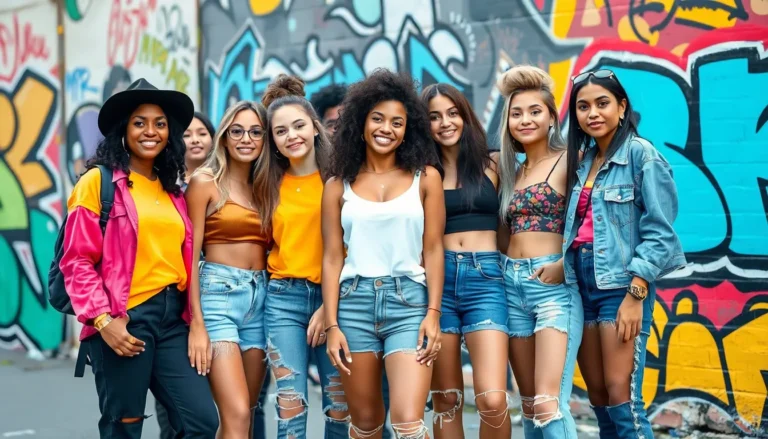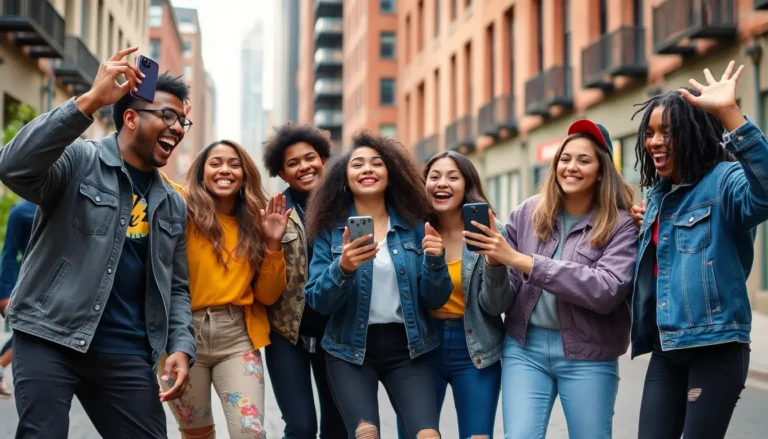Table of Contents
ToggleFashion is a battlefield, and the armies are led by two powerful generations: Millennials and Gen Z. Each group wields its own unique style weapons, from thrifted treasures to high-tech athleisure. As they strut their stuff on the streets and social media, the clash of trends isn’t just entertaining—it’s a reflection of their values and identities.
Millennials, with their nostalgia for the ’90s and early 2000s, often rock vintage finds and statement pieces. Meanwhile, Gen Z embraces a bold, eclectic mix, pushing boundaries with gender-fluid styles and sustainable choices. So, who’s winning this fashion face-off? Spoiler alert: it’s not just about the clothes; it’s about the stories they tell. Buckle up as we dive into the colorful world of Gen Z vs. Millennials fashion, where every outfit sparks a debate and every accessory has a backstory.
Overview of Gen Z vs Millennials Fashion
Millennials and Gen Z showcase distinct fashion identities shaped by their unique cultural experiences. Vintage styles from the ’90s and early 2000s resonate with Millennials, as they embrace nostalgia in their clothing choices. Layering and thrift shopping often define their approach, with an emphasis on sustainability and second-hand finds.
Conversely, Gen Z exhibits a bold, eclectic aesthetic. They prioritize gender-fluid designs and vibrant colors in their wardrobes. Streetwear and athleisure dominate their style, reflecting a blend of comfort and individuality. Social media platforms heavily influence Gen Z, pushing trends that often feature unconventional silhouettes and DIY customization.
Fashion for Millennials often connects to their formative experiences. Influenced by pop culture, they gravitate toward iconic pieces that tell their stories. Brands like Urban Outfitters and Free People typically attract their attention, emphasizing a bohemian flair.
In contrast, brand loyalty among Gen Z aligns with sustainability and ethical production. They favor brands focusing on eco-friendly materials and inclusive marketing. Companies like Aritzia and Everlane often receive positive recognition from this generation.
Tied to social movements, both generations utilize fashion as a form of self-expression. Millennials often incorporate activism into their style, while Gen Z engages in conversations about identity and representation through their clothing choices. Understanding these generational differences shapes the broader narrative of contemporary fashion, highlighting the diverse ways individuals express themselves through attire.
Key Differences in Fashion Trends
Millennials and Gen Z display distinct fashion trends that reflect their values and lifestyles. Each generation adopts unique aesthetics and influences, leading to notable contrasts in style.
Streetwear Influence
Streetwear plays a crucial role in Gen Z’s fashion choices. This generation embraces oversized silhouettes and bold graphics, prioritizing comfort and self-expression. Brands like Supreme and Off-White are favored due to their iconic designs and cultural significance. Millennials lean toward curated vintage styles but often integrate streetwear elements for a relaxed look. They maintain brand preferences for established labels like Adidas and Nike, intertwining athletic wear with nostalgia. Collaborations between luxury brands and streetwear labels further blend these styles, bridging the gap between generational preferences.
Eco-Friendly Choices
Sustainability significantly impacts fashion decisions for both generations. Millennials initially championed second-hand shopping and thrift culture, seeking unique pieces that tell a story. They often support brands focused on ethical practices. Gen Z has taken this a step further, demanding transparency and eco-friendly materials in brands they endorse. Popular options include Reformation and Allbirds, known for their commitment to sustainable production. Both generations express awareness through fashion, but Gen Z’s emphasis on immediate action and activism resonates more in today’s marketplace, reinforcing a collective shift toward environmentally conscious choices.
Fashion Icons and Influencers
Fashion icons and influencers play a pivotal role in shaping the styles of both Millennials and Gen Z. Each generation looks up to figures who represent their values and aesthetic preferences.
Millennial Fashion Icons
Millennials admire icons like Rihanna and Blair Eadie, who epitomize a blend of vintage and modern trends. Their ability to mix high fashion with thrifted pieces resonates deeply with this generation. Gigi Hadid also stands out for her effortlessly chic looks that often blend nostalgic elements. Additionally, Alicia Keys champions authenticity and individuality, inspiring many to embrace unique styles. Brands associated with these icons, such as Urban Outfitters or Free People, frequently reflect Millennials’ interest in sustainable fashion choices.
Gen Z Fashion Influencers
Gen Z follows influencers like Emma Chamberlain and Bella Hadid, known for their bold, eclectic styles. These influencers frequently showcase vibrant colors and gender-fluid designs that reflect their generation’s ethos. Through social media platforms, they promote brands prioritizing sustainability, like Aritzia and Everlane. Another prominent figure, Khloé Kardashian, influences athleisure trends with her relaxed yet stylish looks. Their collective impact solidifies a fashion landscape that embraces individuality while stressing environmental awareness.
Social Media’s Role in Fashion Choices
Social media profoundly influences the fashion decisions of both Millennials and Gen Z. Platforms like Instagram, TikTok, and Pinterest serve as visual inspiration, shaping trends and enabling quick dissemination of styles.
Platforms Impacting Fashion
TikTok stands out as a dynamic space for trend creation, where viral challenges often dictate fashion choices. Instagram continues to function as a space for showcasing aesthetics through styled outfits and thematic feeds. Other platforms like Pinterest allow users to explore and curate their favorite looks, driving style inspirations across diverse demographics. Each platform’s unique format encourages creativity and allows for immediate consumer interaction, reshaping how individuals approach fashion.
Trends Originating from Social Media
Social media trends often lead to rapid shifts in fashion. Viral challenges can popularize specific items, leading to widespread adoption of specific styles. Bold colors and unique patterns frequently thrive on platforms, encouraging users to express individuality. Streetwear pieces, showcased by influencers, attract attention and drive sales, signaling a shift toward casual attire. Vintage and thrifted fashion finds also gain traction as users promote sustainable choices, reinforcing the importance of environmentally conscious shopping habits.
The fashion landscape reflects the distinct identities and values of Millennials and Gen Z. Each generation’s unique approach to style showcases their priorities and influences. Millennials embrace nostalgia and sustainability through vintage finds while Gen Z champions boldness and individuality with a focus on streetwear and eco-conscious brands.
As social media continues to shape trends and preferences, the rivalry between these generations evolves. Their differing fashion choices not only highlight personal expression but also underscore a collective movement toward sustainability. Ultimately, this ongoing dialogue between generations enriches the fashion world, fostering creativity and innovation.







